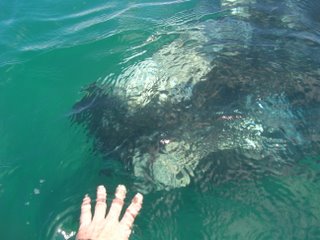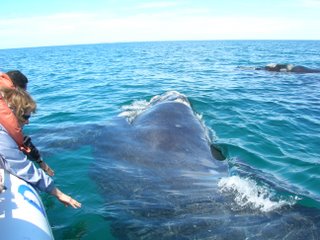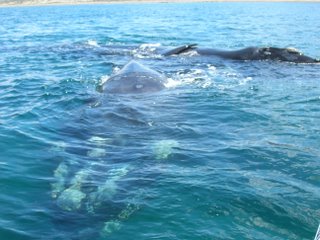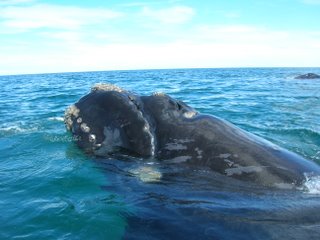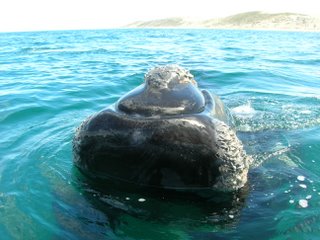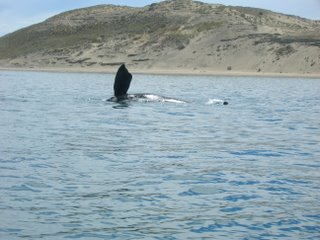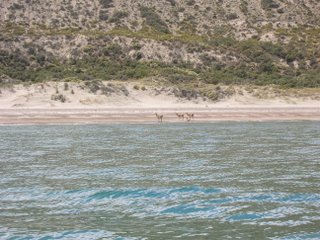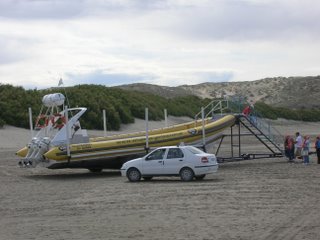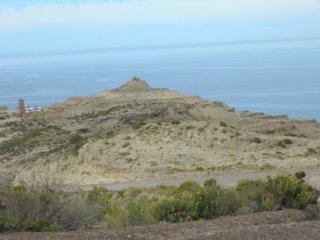Monday, December 11, 2006
Port Stanley, Falkland Islands
Sheep Herders Turned Tourist DroversOur Land Rover driver on today’s excursion to see the Southern Elephant Seals at Kelp Point was a sheep farmer named Georgena. It was her first time driving for a tour. In the Falklands, everybody who lives in “the camp,” as the countryside or outback is called, has a Land Rover or similarly capable four-wheel-drive vehicle. They are essential in the winter mud and in overland access to remote areas. When a cruise ship is in, anyone who wants some extra cash can drive tourists to the remote beaches where wildlife is to be seen. Her brother had signed up to drive, but he fell ill, so here she was.
There were four lorries in our caravan, and one of them was a Toyota SUV similar to a 4-Runner. It did all right but Georgena says she's quite partial to Land Rovers. They are the most common vehicle on the island and are truly impressive in their ability to get over seemingly impossible obstacles. However, on the tender boat back to the ship in the afternoon one guest told me that on the tour he'd chosen, one Land Rover had broken down and another broke an axle.
Georgena was the only driver in our group who had ever been to the remote beach where we hoped to see Southern Elephant Seals. And that was six years ago! She had a hand-drawn map scrawled on some scrap paper, and it was fun seeing how at various stops to open and close sheep gates, the drivers consulted on which was the best way to go. There wasn't one obvious dirt road; it's a maze out on the heaths. Most of the way we were on either lightly used or deeply rutted tracks, but the drivers had to choose tracks by looking at fences and reckoning – and using their honed instinct for getting around boggy areas.
Luckily the weather was warm. Luckily also I had packed for the biting wind I’d experienced here last season, which meant I had plenty of padding with which to make myself comfortable seated cross-legged on the floor of the Land Rover’s far back. There are fold-down seats but they put one’s head perilously close to hitting the ceiling when there are bumps. On the seats you also have to crane your neck down to see out the windows. I propped my pack full of warm layers behind for a lower back rest, folded up my coat for a seat cushion, and used my fleece vest to protect my spine from the grab handle on the inside of the rear door. I was surprisingly comfortable over the bumpy six miles of camp we covered to get near the beach.
Our route crossed a government sheep farm whose lonely farmhouse is now rented out for vacationers. Ewes and lambs in the endless fields watched us approach, but once we'd get close they galloped off comically. Since it’s Spring here, there were many lambs, and we learned a bit about sheep husbandry from Georgena’s lifetime of experience.
On one lonely hillside I spotted a Turkey Vulture jumping onto the carcass of a big fleecy sheep. Georgena explained that sheep often lie down and get stuck on their sides. They may be alive, even healthy, but if their fleece is soggy or they are weak, they may be unable to get up. Then the vultures come and peck out their eyes, pick at any vulnerable bits, and eventually kill the sheep. If a farmer comes along when the animal isn’t too far gone, they can just pull the sheep upright and it’ll trot off and live out the rest of its days. Otherwise, ranchers carry a knife to finish off sheep that are suffering too much.
When we were driving back from the beach, I spotted the same sheep on the hillside, with a Turkey Vulture standing on it. This time the sheep was thrashing periodically, its legs waving into the air as the vulture jumped out of the way and landed right back on the poor thing. I called out to Georgena that the sheep was still alive. She veered out of the line of trucks and took off bumping across the grassland toward the downed ewe.
Our shepherd driver pulled to a stop so close to the animals that the vulture’s wings filled the window frame as it launched away. She hopped out and I jumped out the back door too, hoping not to see anything too horrible. Thankfully the sheep was fine – she still had eyes, she was healthy. Without pause Georgena stepped around to the sheep’s belly and reached over its back to sink her hands into the deep fleece. With one good pull she lifted the struggling animal onto its feet and it trotted right off, wobbling.
At first it looked like the ewe had a broken leg, but Georgena said their legs fall asleep when they’re down for a while. Sure enough, as we watched, the sheep got stronger with every stride and got away from us as fast as she could. We were so happy! What a way to get a taste of local life! How often do you get to save a life on your vacation? Wow.
The Whale GraveyardThe coastline of the Falklands is convoluted and inset by innumerable mazes of saltwater inlets. That’s why we had to drive so far around ponds and marshes to get to a beach that was only a mile or so from the main road. At long last we came down onto a small bay of royal blue water framed by two low headlands. As we turned onto a track parallelling the beach I spotted a lone penguin waddling up from the water’s edge. It was a Gentoo, and Georgena spotted a small colony inland a ways from us. It was quite dear to watch this poor scared bird running and trying to get across this road in the middle of nowhere. We had to stop and let it cross. Jokes about penguins crossing the road ensued for the rest of the day.
What caught my attention, though, was a large white piece of whale bone on the upper beach. It was the cranium of a baleen whale. A few yards farther, the jawbone of a sperm whale arched up out of the sand. I couldn’t believe it! Was this a whaling beach? There were whale bones everywhere!
Even though the other lorries were far ahead down the beach, Georgena stopped and let us out for a quick look. Everywhere we walked there were huge vertebrae growing lichens, ribs half buried in the blowing sand, fragments of the rostra of rorquals (big baleen whales), and a spare humerus (upper arm bone) here and there. One guy brought me the cranium of a small dolphin. I found a pilot whale jaw. It was incredible. I could have spent the whole day there.
Whale osteology is one of my favorite things in the world. When I was in high school I volunteered for the Curator of Marine Mammals at the Smithsonian and one of my tasks was to number newly accessioned dolphin bones with their unique specimen number. That took me, for many memorable hours, into the “Bone Room,” a low-ceilinged, sweet-smelling cave in the basement of the museum where case after case of dolphin, seal, sea lion, and manatee bones are stored.
On top of the cases are the bones too big to fit inside: rows of killer whale skulls, narwhal tusks, minke skulls, big vertebrae. Suspended from among the dusty ceiling pipes are old mounted skeletons of sea lions, strange beaked whales, and little dolphins, and fading plaster models of porpoises from defunct exhibits. It’s heaven for a bio geek artist kid, and it’s still my favorite place in the museum.
After college I did an illustration of a young Minke Whale skull there, and spent many days studying its details. I also did an illustration for an exhibit that showed how the Blue Whale skull in the Marine Life Hall fits into the life-size model of a Blue Whale (that exhibit is gone now). It is still always a treat when my mentor, Jim Mead, the curator, gives me an impromptu lesson in anatomy. Cetacean bones, skulls in particular, look nothing like any terrestrial mammal. It takes a lot of looking and explanations to figure out how what you’re looking at relates to the whole animal.
As an illustration intern at the Smithsonian I did an ugly job to earn some extra money: flensing dolphin skulls. That means cutting the meat off the head so the bones can be dried and cleaned for preservation in the collection. Since it’s illegal to kill dolphins even for science, these were all strandings from beaches all along the East Coast. Some of them were quite ripe, that is to say, rotten, when they were brought back and frozen. I had to thaw them before getting to work.
Some of the heads were pristine and fresh, though, and two stand out in my memory for their sheer beauty. Both were Bottlenose Dolphins,
Tursiops truncatus. One was a huge adult male from an offshore pod. He had exquisitely nuanced shades of gray striping on his smooth face. The other was a minuscule infant
Tursiops, so tiny and delicate, yet with taut, perfect skin. With fresh specimens like those I spent extra time dissecting to learn more about how their jaws and air passages worked. They are so beautiful, and so incredibly ingenious in their adaptations to an aquatic life.
I’ve also spent time with Humpback Whales in the field in Alaska, and have spent hours discussing their functional anatomy with my illustration mentor, Pieter Folkens. I was so curious about Humpbacks after seeing them up close that in 2001, when I had a chance to visit the warehouse of the L.A. County Museum, I spent hours among the humpback skulls in their collection, sketching them from different angles and figuring them out.
That’s how I knew what I was seeing when we came upon the beach. It wasn’t a whaling beach, though. These were all strandings or carcasses washed ashore. Georgena says they regularly get mass strandings of pilot whales, which are large black dolphins with bulbous heads well known for this mystifying suicidal behavior. Lots of beaches on the Falklands are strewn with whale bones, if they are directly open to the sea and exposed to the wind. This one fit the bill.
The Great Southern Heffalumps
We went on to another beach for the elephant seals. We rounded a point and there they were, great big males hauled out on the grass above the beach, snoozing. To my chagrin I realized that there was no designated guide in the group, only the assorted drivers, who had given no briefing on how to behave around the animals. As we got out of our lorry another driver came over and suggested not getting too close, and not going between the big guys and the beach.
It was too little warning, too late -- people from the other trucks were already walking up to the behemoths to get close-up pictures. These things weigh five and a half tons! They have massive canines and can move a lot faster than a human if they are angry. They are flat-out dangerous.
An older gentleman from my vehicle turned out not to understand English. We didn't discover this -- nor that he was hard of hearing -- until several people were shouting at him to get away from a group of three males. He couldn’t have been more than five feet from them. Finally he got the message and came away from the bulls with no mishaps.
Eventually I was satisfied that everyone had figured out not to get too close, and I was able to start enjoying the birds and the beauty of the place. It was still sunny though very windy. Falkland bird life made itself delightfully evident in a trio of Magellanic Oystercatchers working and peeping along the shore, a family of smallish black-billed ducks including three fuzzy gray ducklings along the water’s edge (probably Patagonian Crested Ducks), Kelp Geese, Upland Geese, Black-necked Swans on a nearby lagoon, and an assortment of shorebirds.
We had a good forty minutes with the elephant seals. I had time to walk along an unpopulated part of the beach and find elephant seal jawbones among the stones. I set up a spotting scope to watch males battling in shallow water off the beach, and to spy a couple of pups on a small cobblestone island a few hundred yards offshore. It was a great visit, and the day wasn’t over yet.
Pinguinos IncognitosGeorgena led us back along the whalebone beach and then turned abruptly off the track into the tussock grass toward where she’d seen the penguins. It was treacherous going in spots but she ably guided us to a rather imperative stopping point, where any further we’d have been bogged. I finally had my first experience with true tussock grass like in the Arctic tundra. It would be very easy to turn an ankle falling into the concealed ten-inch drops between grassy mops.
This penguin colony didn't even have a name. The penguins were Gentoos, the really cute kind with a red bill and a white triangle over their eyes. There were only about fifteen pairs plus another fifteen lone adults, and each bird on a nest had one or two chicks. The chicks were beautifully cute in their handsome light gray down and curious eyes. They were about a quarter mile from the beach, far enough inland to be very safe from big waves and marine predators. In the Falklands they have to worry about rats, feral cats, and skuas raiding their nests. And tourists. They definitely noticed us, but nobody on a nest budged. It was lovely to see those half-grown chicks. Last season they were all molting into adult plumage when I saw them.
This time I was prepared to be the guide, and since our lorry had arrived first I was able to tell everyone in each truck that the penguins were breeding and we shouldn’t get too close. I went forward toward the penguins with the first people and told them when to stop, and they did. One woman insisted on being several steps ahead and getting in the way of everyone else’s photos, and another guy went off to one side to get good shots with his telephoto, but he didn’t get too close.
Then the same older gentleman walked past everybody right up to the penguins, stopping only ten feet away. He must not have understood the instructions and was probably wondering why nobody was going closer. I went to bring him back and called out, “Sir! Señor! Monsieur!” He turned around and said clearly, “I can’t understand you. I don’t speak English.” So I asked, “What language do you speak?” Spanish. I managed to convey in español that he was too close and to my surprise he obligingly backed away. He even thanked me, and I made a point of being very polite, thanking him too, and making small talk on the drive back. It was frustrating for me but also for him. It must not be fun to be left out of the conversation in a tightly packed car for four hours because of hearing and language difficulty.
What a wonderful day, a nice sense of discovery I saw many new bird species, enjoyed the elephant seals, and the penguins were darling. Even learned a bit about guiding and brought back a happy, satisfied group of guests. Everyone loved it. And I know I want to spend much, much more time in these fantastic southern islands.
 The boat is a longliner that caught its load of sharks outside the 200-mile territorial waters of Brazil. It is about 100 feet long and crewed by nine sailors, two engineers, a cook, the skipper, and two fishermen who bait the thousands of hooks they soak in the sea for a day or so before reeling the line in. The fish are flash frozen after being finned, decapitated, and probably bled. The vessel traveled four days out to the fishing grounds, spent ten looking for fish, and caught a hold full in 43 days. The ship is Spanish-owned and the whole catch, including some yellowfin tunas and swordfish, plus bag after bag of shark fins, was being loaded into three shipping containers to be sent back to Spain. I wonder if the shark fins will go on to China or be sold in Europe.
The boat is a longliner that caught its load of sharks outside the 200-mile territorial waters of Brazil. It is about 100 feet long and crewed by nine sailors, two engineers, a cook, the skipper, and two fishermen who bait the thousands of hooks they soak in the sea for a day or so before reeling the line in. The fish are flash frozen after being finned, decapitated, and probably bled. The vessel traveled four days out to the fishing grounds, spent ten looking for fish, and caught a hold full in 43 days. The ship is Spanish-owned and the whole catch, including some yellowfin tunas and swordfish, plus bag after bag of shark fins, was being loaded into three shipping containers to be sent back to Spain. I wonder if the shark fins will go on to China or be sold in Europe. When I first walked up and saw the crane lifting a string of twenty sharks by ropes in their tails, I wanted to cry. There was all the swimming beauty of the sea mutilated and frozen, being thrown like hunks of wood into trucks. But I stuffed down my feelings and played along with the macho poses of the deck hands so I could get pictures of them holding up shark fins and tails. I'll use them in my lectures to teach the guests about the shark overfishing crisis.
When I first walked up and saw the crane lifting a string of twenty sharks by ropes in their tails, I wanted to cry. There was all the swimming beauty of the sea mutilated and frozen, being thrown like hunks of wood into trucks. But I stuffed down my feelings and played along with the macho poses of the deck hands so I could get pictures of them holding up shark fins and tails. I'll use them in my lectures to teach the guests about the shark overfishing crisis.
